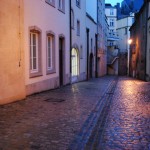Luxemburg
Luxemburg – the capital of the Great Duchy of Luxemburg located in Western Europe
Luxemburg was founded on April 12 in 963 by a close relative of the kings of France Duke Siegfried who took possession of the rock called Bock. He founded on it a knight’s castle which later became a fortress. Around the Duke’s property houses and shops of merchants and craftsmen began to get built. The castle and the city got their name after fortified tower built under the Romans Lucilinburhuc which in old German meant “small castle.” Then this name was transformed into Lucemburg, Lucelburg, Leceburg. The name Luxemburg appeared after the first joining of the Duchy with France (under Luis XIV), but it became the official name only after the Congress of Vienna in 1815.
The city has been besieged 22 times, it has joined many different countries, it was once almost sold. But it has survived and now is over one thousand years old.
Luxemburg is an amazingly beautiful and unique city. Two rivers – Alzette and Pétrusse – flow through the city and divide it into two parts: the Upper city with remains of the mighty fortress, the Ducal Palace and many ancient buildings and the Lower city with new quarters. The difference in height between the Upper and the Lower cities is 65 meters. Different parts of the city are connected by 66 bridges.
In the Upper city Gothic style of the buildings with narrow towers and pointed high into the air steeples predominates. One of the peculiarities of the city is the rocks and caverns with dangling threads of grass and moss. In some places precipices have terraces on which small parks are laid out.
The most interesting architectural monuments of the Upper City are the partially graven in the wall chapel Saint Kiren (VI century), the Gothic church Saint Michelle and the former city hall.
On one of the central squares – square of Wilhelm – is the building of the city administration. Nearby is the Ducal Palace built in 1580, with tall towers and steeples. The Parade square is the center of the city life where parades, festivities and celebrations are held. There is a high monument built on it – to the poets Lenz and Dikk. Near the square a park is laid out.
In the center of the city 20-storied and 25 storied buildings are built, in which there are 115 banks and 5 and a half thousand companies – holdings as well as different transnational representation offices. The huge viaduct – the Adolph Bridge – connects the center of the city – the Boulevard Royal – with the Liberty prospect. The steel bridge named after Grand Duchess Charlotte connects the center of the capital with its most modern suburb Kirchberg where the European Center is located – the place of the meetings of the Council of the ministers of the “Common Market.” From the 22nd floor of the flat tower of the European Center the entire city of Luxemburg can be very well seen.
In the capital there are many monuments to statesmen, composers, poets, scientists. The monument to the king Wilhelm the II is located on the Place Guillaume II square. The king, a participant of the Battle of Waterloo, is depicted sitting on a battle horse. In front of the building of Athenaeum where scientific and literary societies are located is the monument to Michelle Rodange, the famous Luxembourgian poet. In a city park there’s a bust of the writer Victor Hugo.
In the capital there’s the National Museum with a big collection of interesting displays, the conservatory, the National Theater. The National Library has more than 350 thousand of volumes of books.
In Luxemburg there’s a lot of verdure, especially in the valleys of the rivers Alzette and Pétrusse. The valley of the river Pétrusse is the most beautiful place in the city. It is a forest park with a big number of alleys, paths, secluded nooks among which there are steep sharp rocks with deep and narrow crevices. There are many hunchbacked pedestrian bridges across Pétrusse.
Luxemburg is famous for being the city of roses. The roses “Luxemburg” are famous all over the world and have been displayed at international exhibitions of flowers numerous times. The roses of Luxemburg can be seen in city gardens of Moscow, Rio de Janeiro, Wellington of New Zealand, Ottawa of Canada and so on.
.

